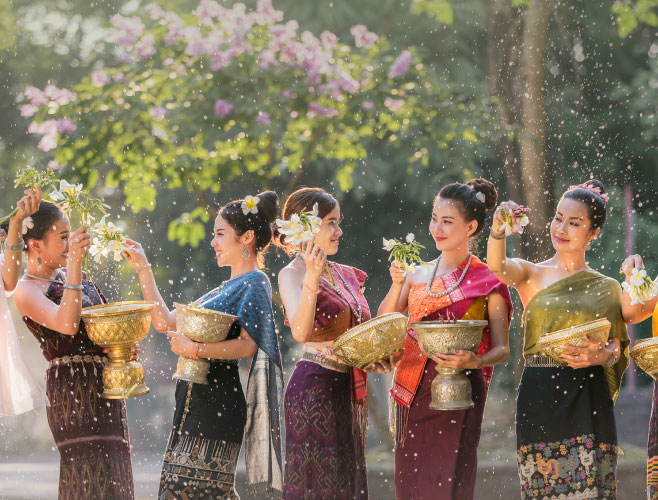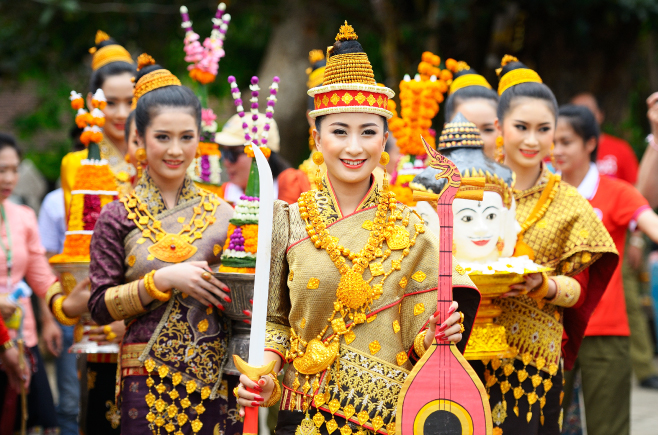The Colorful And Vibrant National Costume of Laos
June 01, 2023
Laos is a country bordering Vietnam, but culture and tradition have completely different features. Laos is famous for its majestic mountains, popular Buddhism, and interesting traditional festivals. The cultural beauty of this country attracts the curiosity of many people. When talking about the cultural traditions of a country, it is impossible not to talk about traditional costumes. For Laos, their traditional costumes are very special. Men and women have their own costumes and names. In this article, let’s find out more about the origin and features of Laos traditional costume.
History of Laos Traditional Dress & Costumes
From a young age, Lao women are skilled in the art of weaving, which is considered a traditional beauty that highlights their gracefulness. A desirable wife in Lao culture is one who is a skilled weaver. Since ancient times, every village in Laos has been self-sufficient in producing blankets. When dyes are unavailable, they use natural resources from the mountains to add color. Young women in Laos often prefer dressing in bright hues with flowery and plaid patterns reminiscent of the country's mountains and forests. However, the choice of dress and pants style is also influenced by practicality and seasonal requirements. Therefore, there are many clothes suitable for each activity such as festive costumes, labor costumes, funeral costumes, and wedding costumes, and so on.
The Laos traditional costume is known as "xout lao," which means "Lao outfit" in English. The appearance of this Laos traditional clothing, which consists of several components, may be influenced by the event or location in which it is worn. The xout lao is worn by men, women and children, although the style varies.
In Laos, the "sinh" has a lengthy history. Ms. Kongdeuan Nettavong, a scholar who spoke on the history of "sinh" at a seminar last year, claimed that practically all of Laos' ethnic groups wear sinh, each of which has its own distinctive style. About 3,000 years ago, Laotian women reportedly donned the "sinh" for the first time. The "sinh" has developed into a distinctive emblem that sets Laotian ladies apart from other women. Wearing a “sinh” has become a unique symbol that separates Laotian women from others.

Laos women often choose to wear bright colors and patterns inspired by the country's natural scenery
What Does Laos Traditional Clothing Represent?
Laos' ethnic diversity and rich cultural legacy are reflected in the country's traditional attire. Different ethnic groups in Laos have distinctive clothing that is frequently intricately woven and embellished with vibrant embroidery and designs. Lao's traditional clothing designs and patterns reflect the surroundings, morals, and social standing of the people who wear it. For instance, the Lao Loum people's attire is more straightforward and frequently has geometric designs, but the traditional dress of the Hmong people is distinctive and frequently includes elaborate needlework that represents nature and animals. Overall, traditional clothing in Laos is a symbol of cultural identity and pride, and it is still worn on special occasions such as weddings and festivals.
Sinh – The Laos national costume female
Laos women are supposed to appear stunning since they are revered as the country's mother in their culture. When visiting Laos, you will see Lao women selling agricultural goods and working in the fields while donning simple Sinhs with some decoration. However, during significant Lao ceremonies, many women adorn themselves with vibrant scarves, blouses, silk skirts, and sparkling jewelry and coil their hair. The traditional attire for Lao women comprises a handmade silk skirt called a "sinh," paired with a long-sleeved shirt called a suea pat wrapped around the body. The "sinh" ensemble consists of three primary components: the "hua sinh" - usually woven in 1 or 2 different colors, the "phuen sinh" (body of the skirt), which is typically plain and unadorned, and the "tin sinh" (bottom border), which is the most elaborately woven part, sometimes even decorated with gold. Women complete their traditional attire with a pha biang, a thin garment draped over one shoulder, and scarves with the same decoration as the "sinh" draped over their bodies. The big difference between “Salong” and “Sinh” is that it is a big pant or peasant pant.

Sinh is the Laos national costume female
Salong – Laos national costume male
The traditional dress of Lao males is SaLong, a huge pair of pants in many colors, as opposed to the Sing costume worn by Lao women. These unique pants are a common sight on Lao males during formal events like weddings and ceremonies as well as sporting events. White knee-high socks, a biang, and a salong are typical outfit combinations. In addition, Yao and hung is a wrap-around garment with the ends twisted together, pushed between the legs, and fastened to the waistband in the rear that Lao men frequently wear. Yao or hang is composed of strong silk and intricate needlework, yet it takes a lot of time and works to manufacture.
If you have had a chance to visit Thailand or Cambodia, you will realize that the “Sinh” is a little bit similar to Thais or Cambodia’s traditional skirt. It is understandable because they are three neighboring countries. Traveling to Laos is a great choice for all types of tourists. Taking Laos tours, you will have a chance to wear an impressive national costume of Laos. Do not forget to buy a set of Laos Sinh for your own and pick up some sets for your family members or friends.

Traveling to Laos is a great choice for all types of tourists
Laos Traditional Dress & Costumes in Holidays & Festivals
Laotian traditional clothing is frequently worn for a major occasion or function, and in many rural regions, children may be seen wearing "tube skirts" to school. Otherwise, the colors of "sinh" and "salong" vary depending on the event, such as a festival wedding or burial.
Laos Traditional Clothing in Wedding Ceremony
A wedding ceremony is a significant event in Laos. The groom and bride will dress in traditional attire with brilliant colors and gold accents to signify the proclivity. The more affluent the household, the more sophisticated the clothing.
Laos Traditional Dress in Festival
Festivals are times when people get together to celebrate and spread joy. As a result, the custom is really vibrant and brilliant.
Other Facts about Laos Traditional Dress & Costumes
People in the city or central areas no longer wear traditional clothing, although it is still common in rural Laos. Silk "Sinh" or "Salong" of good quality is used in ceremonial and celebration. Meanwhile, the "sinh" that is worn on a daily basis in rural areas is made of cotton weave and is cooler, making it more comfortable to carry out daily duties.
Last but not least, a visa is necessary for any trip to Laos. Thanks to the electronic visa system, apply for a Laos visa is simple. This kind of visa is given to visitors going to Laos for brief vacations or unscheduled visits to family. To fully experience Laos, get in touch with Global Visa Services immediately now and get your legal travel authorization!
Tags




